Reduced VOC benefits for the paint products
Introduction
Volatile organic compounds or VOCs are recognised for their negative impact on human health and the environment but less often mentioned in the context of their benefits for the paint product quality and performance. Consumer demand for safer and environmentally friendly products grows and the coating industry responds by investing more in reducing their environmental impact and creating well performing, competitive water-based coatings as alternatives to the VOC-heavy solvent-based paints. This blog post will reintroduce the subject of volatile organic compounds and provide insight in the main performance benefits of paint products with reduced VOC content.
Why reduced amount of VOCs matters
Volatile Organic Compounds (VOCs) are all the organic compounds used in paint products, they are chemicals that easily evaporate during their application and are recognised for their negative impact on human health and the environmental.
For more information about VOCs visit our blog post: link
According to the Environmental Protection Agency (EPA): “VOCs pose a risk to health and the environment. In still, sunny conditions and in the presence of nitrogen oxides (contained in vehicle exhaust gases), VOCs react to form ground-level ozone. Ozone is one of the components of summer smog and harms human health through respiratory illness, crops and the general ecosystem. Ozone can be transported over long distances, possibly hundreds of kilometres, from where it is formed (a).”
Coatings with reduced levels of VOCs are most typically water-based and high solids paints that require proper engineering and application to provide competitive performance qualities and to be considered as better alternatives to solvent-based coatings. With adequate formulations these coatings then provide good and possibly even higher performance providing characteristics like “UV protection, stain performance, abrasion resistance and water repellency” amongst others (b).
Measurements for the VOC content in paint products in the coating chemistry typically are calculated in grams per litre or pounds per gallon (b).
Recognising the VOC levels of a particular paint product can be done through examining paint packaging, where typically for all decorative coatings it will be displayed as a category from minimal (very low VOC content) to very high (Figure 1). Paint label may also display statement of zero or no VOC content, while products with environmental label will automatically indicate minimal or low contents of VOCs (c).
Figure 1. VOC levels categorisation and labelling examples (c, g).
|
|
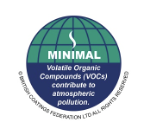 |
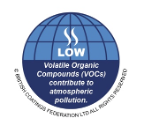 |
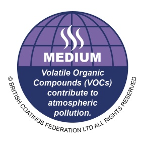 |
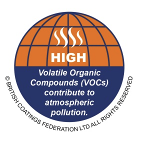 |
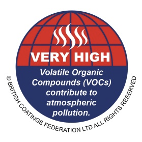 |
|
VOC level gm/L |
<5 |
5-49 |
50-99 |
100-249 |
>250 |
Figure 2. VOC levels allowed in categorised coatings according to the EU regulations (c, h).
 |
 |
 |
|
| VOC level gm/L | 5-49 | 100-249 | >250 |
| Water-based |
|
|
|
| Solvent-based |
|
|
|
Regarding decorative coatings, the European Union directives set the VOC limits that vary depending on the category of coatings and more importantly to whether the coating is water-based or solvent-based (Figure 2). Both solvent-based and water-based interior matt wall and ceiling coatings are required to comply with low VOC levels, while coatings in other categories are more dispersed and allow for higher VOC concentrations. Thus, the interior glossy coatings as well as trim and cladding coatings for wood and metal are allowed to have high levels of VOCs, therefore it is advisable for the general public to recognise VOC levels and make informed product choices with regard to their well-being and the environment. While water-based coatings generally have lower VOC levels, it should be also recognised that there are categories being less restricted in their VOC emissions by policymakers (h).
Regarding human health, considering VOC free paints and paints with low levels of VOCs are better and safer choices in comparison to the conventional paints but it must be noted that these levels do not indicate a completely safe product, since they can still contain semi-volatile organic compounds that may cause health reactions in chemically sensitive people, small children and people with pre-existing health conditions. Typical sources of semi-volatile compounds in paints are hydrocarbons, aldehydes, ethers, esters, phenols and others. If the paint ingredient list is available, they should be avoided in case of health concerns (d).
Performance of reduced VOC paints
Reduced VOC paints typically are water-based (latex and acrylic) paints as well as high solids paints. Therefore, to illustrate the performance benefits of low VOC paints, it is worth to compare their performance and benefits and those of solvent-borne oil-based paints (high VOC content). It should be noted that the low-VOC paints are a significant subcategory of water-based paints.
- Durability Water-based coatings show better elasticity than oil-based coatings and good adhesion to most substrates, with the exception of heavily chalked substrates where oil-based paints show better performance. Conventional solvent-borne paints can show yellowing in indoor applications requiring more frequent repainting to maintain paint performance and thus involving more money and resources spent. Additionally, solvent-borne coatings (high VOC) are claimed to lose up to 20 percent of the film thickness during application and drying of the film that negatively impacts the long-term performance of coating.
- Colour retention Water-based paints are better than oil-based paints at resistance to colour fading and chalking.
- Ease of application Water-based paints are easier to apply smoothly and evenly than oil-based paints. Water-based paint application in wet and very low temperatures is still one of the challenges that manufacturers of water-based coatings are working towards to improve but an efficient lower-VOC coating alternative in these conditions would be a high-solids coating product.
- Odour Due to the reduced content of VOCs, water-based paints have very neutral odour as opposed to the oil-based paints. Also, water-based paints are regarded as non-flammable.
- Clean-up Water-based paints are easy to clean with water and they require no chemical input as opposed to the oil-based paints that require a solvent for clean-up. Solvent being the main source of VOCs, this is a significant criterion in favour of choosing water-based paints.
- Drying time Film of the water-based paints dries in a significantly shorter time (1-6 hours) than oil-based paints (up to 24 hours), meaning that a painting project that involves water-based paints will require shorter overall time due to reduced time between painting multiple layers (f, g, i).
References:
Closing
Paint products with reduced levels of VOCs are water-borne coatings with reduced solvent concentration in their formulation. As consumer awareness regarding VOCs associated with negative health and environmental impacts increases, policy makers and coating manufacturers both make an active effort to establish low-VOC coating market and better recognition of VOC levels in paint products. Although the health and environmental benefits of low-VOC coatings are well understood, consumer hesitation toward these types of coatings may still be linked to doubts about product performance. However, according to multiple sources, innovations in paint product formulation has led to low-VOC coatings that are equal to their counterparts and in some performance categories even outperform the solvent-based coatings. In choosing low-VOC coatings it is advisable to pay attention to the paint product category, VOC level marking on the packaging as well as if the particular paint product has been recognised by an environmental label.
Author: written by Anse Romančuka, edited by Linda Kikuste





 Facebook
Facebook

 Linkedin
Linkedin

 Google
Google